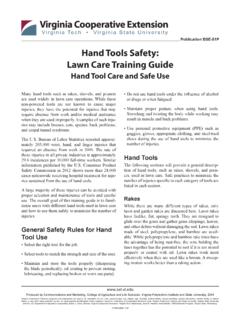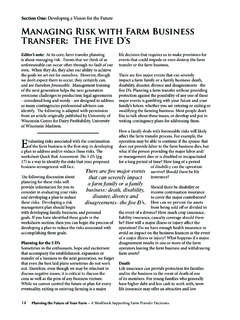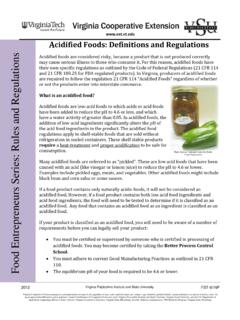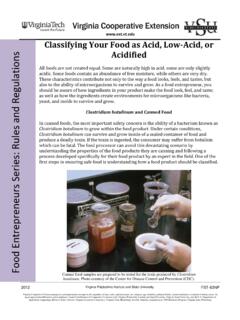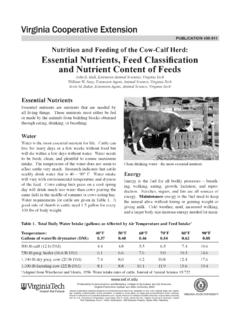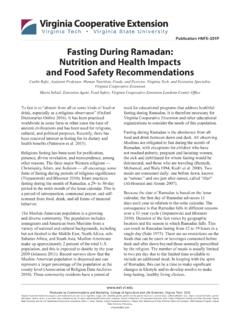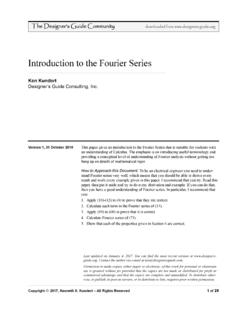Transcription of Publication Trees and Shrubs for Acid Soils - …
1 Publication by Communications and Marketing, College of Agriculture and Life Sciences, Virginia Polytechnic Institute and State University, 2015 Virginia Cooperative Extension programs and employment are open to all, regardless of age, color, disability, gender, gender identity, gender expression, national origin, political affiliation, race, religion, sexual orientation, genetic information, veteran status, or any other basis protected by law. An equal opportunity/affirmative action employer. Issued in furtherance of Cooperative Extension work, Virginia Polytechnic Institute and State University, Virginia State University, and the Department of Agriculture cooperating.
2 Edwin J. Jones, Director, Virginia Cooperative Extension, Virginia Tech, Blacksburg; Jewel E. Hairston, Administrator, 1890 Extension Program, Virginia State, and Shrubs for acid SoilsBonnie Appleton, Extension Specialist, Hampton Roads AREC Robert Heins, Graduate Student, Hampton Roads AREC; Virginia TechStephen Donohue, Crop and soil Environmental SciencesGregory Eaton, HorticultureDawn Alleman, Norfolk VCEJim Williams, Hampton VCE; Virginia TechReviewed by David Close, Consumer Horticulture and Master Gardener Specialist, Horticulture, Virginia TechThe Trees and Shrubs on your new home site are growing poorly, so you take samples to the Extension office and the agent suggests a soil test.
3 Test results show that your soil has a pH of , which is rated as strongly acid . The agent suggests you either take corrective action to raise the pH or grow different do the test results mean? What are acid Soils and what does pH measure? Why does this matter to your plants? How can you correct the situation or what alternative Trees and Shrubs can you grow? acid soilsAcid Soils are all Soils that test lower than pH , which includes most Soils east of the Mississippi River. In reality, most of these Soils do not have significant acidity problems.
4 Soils with pH s below may need special treatment or plant selection. When Soils become very acid , however, with pH s below , problems develop Interveinal chlorosis often develops when soil pH, that is either too high or too low for a particular plant, makes an important nutrient unavailable for plant many common landscape Trees and Shrubs . These strongly acid Soils need either amendment to raise the pH or careful plant selection. pHpH measures the available hydrogen ions in a solution, and describes the relative level of acidity or alkalinity measured on a scale of 1 ( acid ) to 14 (basic), with as neutral.
5 Vinegar is a mild acid ; battery acid (sulfuric acid ) is a strong acid . Baking soda is a mild base when mixed with water; lye (Drano) is a strong base. Pure water is neither basic nor acidic, and has a pH of The pH scale is logarithmic, with 14 gradations. Each increment of actually represents a difference of ten times either more basic (alkaline) or acidic ( , is ten times more acid than , is a hundred times more acid than , and is a thousand times more acid than ). acid Soils are often called sour Soils and basic Soils are often called sweet nutrients are available to plants for uptake and use only when they are dissolved in water as ions.
6 Nutrient availability differs depending on the pH of the soil solu-tion. A soil pH range of to provides the greatest compromise of nutrient availability for plants. Moving away from the pH to range makes some nutri-ents more available, while decreasing the availability of others. A decreasing or more acid pH not only makes some nutrients less available, but it may also cause others, such as Al and Mn, to become available in toxic concentrations. Causes of acid soilsAcid Soils may be due to natural conditions or human disturbance of the soil .
7 The same methods for adjusting acidity are recommended for either situation. The pri-mary difference is that naturally acidic soil will eventu-ally return to that state after pH adjustment, while pH adjustments to disturbed Soils present a more long term change. Naturally acid Soils occur when bedrock from which the soil evolved provides the natural elements for acidity, when rainfall leaches or washes away basic elements in the soil , or when land has been naturally forested. All of these situations are present in Virginia soil pH s range from to with most in the to range.
8 Virginia rainfall is high, averaging 40 to 45 inches per year. Over time this rainfall has carried away water-soluble basic elements ( , Ca, Mg, K, NA), thus resulting in acid Soils . High rainfall has also supported Virginia s forests. In contrast, low rainfall tends to produce natural grasslands with minimal leach-ing and thus alkaline (basic) Soils . Manmade acidic Soils occur as a result of mining operations, farming, construction site development, and similar events that remove topsoil and expose the naturally acidic subsoil, or that deplete the soil of basic-forming elements.
9 What is left is usually lacking in organic matter and available nutrients. While pH recovery can occur naturally, it will be slow, as will be plant reestablishment. Landscape fertilization practices can also affect soil acid -ity. Repeated use of high ammonium or urea fertilizers, especially to turf areas that cover tree roots, can com-pound acidity problems. In situations where the soil is too acid , it may be better to use more basic fertilizers, many of which are nitrate based. Water used for land-scape irrigation can also contribute to acidity problems and, therefore, it is valuable to have both your soil and your water tested before taking corrective acid pHAdding ground limestone, either calcium carbonate or calcium-magnesium carbonate (dolomitic lime) raises the pH of acid Soils .
10 Quicklime and slaked lime are also used and act faster, but are more expensive and disagree-able to use. The amount of limestone needed to change the pH of the top 8 inches of soil from to a desired varies according to soil type and ranges from approx-imately 150 lbs/1000 ft2 for a sandy soil to 250-300 lbs/1000 ft2 for a clay loam. The rate needed will be provided as part of the soil test results from a soil testing lab, if the soil type and the intended use of the land are listed when the soil sample is , lime should be worked into the soil to a depth of at least 8 inches.
